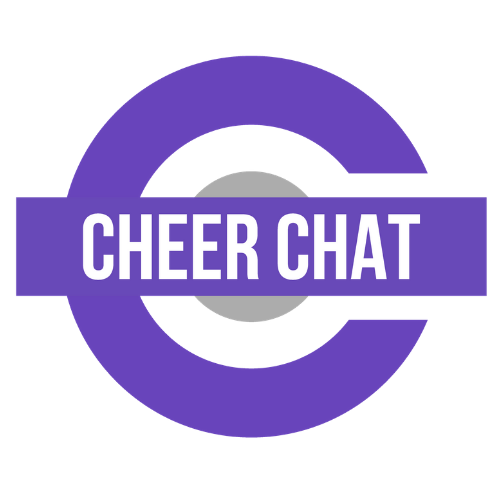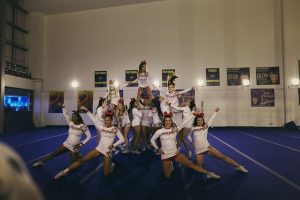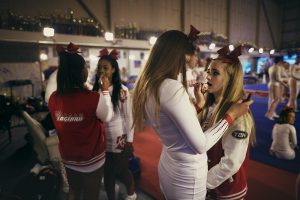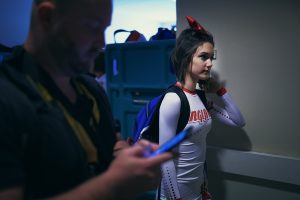The perception of cheerleading changes depending on who you speak to. Modern-day cheer maintains various traditional aspects, although it has now evolved into a sport in its own right. In this article, we’re going to breakdown the different components of cheerleading and answer the common question of “what is cheerleading?”
What is cheerleading?
Cheering
As the name suggests, cheerleading usually involves using unique cheers and chants to encourage and inspire crowds. Typically this was done on the sidelines (more about further down) to support a team by cheering and chanting, however, this has since combined the same elements into competitive routines.
Dancing
Dancing has always been a fundamental skill in all aspects of cheerleading. Elements such as poms, kick lines, and synchronised formations are commonly used in sideline performances. Since the early days of cheer, more technical aspects of dance have been added to the choreography and remains a key component in modern cheer routines.
Tumbling
Jumps have always been a popular element of performances ever since cheer started. Since then, the athleticism has grown exponentially and more complex gymnastic techniques have been introduced.
Today’s cheerleaders can be seen jumping, twisting, diving and flipping in a similar way to elite level gymnasts. Currently, teams will usually include rolls, cartwheels, walkovers and round-offs in their choreography.
Stunting
Stunting is a building performance where two or more athletes stack on top of each other to create a visually impressive pose. The athletes at the bottom are known as the bases, back spots, front spots and additional spotters (placed around the mat for increased safety), whereas athletes on top are referred to as ‘flyers’ or ‘top girl’.
Athletes create stunts, pyramids and dynamic basket tosses and incorporate their acrobatic skills into partner, small and large group routines. These techniques are now essential in any competitive cheerleading routine and are an important aspect of the judge’s scorecards.
Types of Cheerleading
Sideline Cheer
Sideline cheer is where athletes cheer as a form of motivating a sports team, hype up the crowd and to provide entertainment at half time intervals. This would usually take place at the side of a pitch during sports games like American football or basketball.
Their purpose is to encourage the home team to win and the home crowd to increase their support. Animated slogans, dancing and chanting are often seen in sideline cheer.
Competitive/Allstar Cheerleading
Competitive cheer generally blends all of the main elements mentioned above and then incorporates many more skills to create a full routine. It’s a full-on sport and there are different levels at which you can compete depending on age and/or ability.
These athletes demonstrate more diverse and complex techniques and compared to sideline cheer. The difference is also that they compete against other cheer teams in front of judges. These judges will score a team based on ability with a focus on difficulty level, execution and performance.
Their routines are generally more complicated and show a combination of tumbling, jumps, stunting and dance. The performances are usually around two and a half minutes in length and are choreographed to background music.
Paracheer
Paracheer involves the main elements of cheer and combines athletes with or without disabilities. Many traditional techniques such as jumps, dance, tumbling and stunts have been adapted for Paracheer.
This has evolved cheerleading even further into a much more progressive and inclusive sport, resulting in new innovative routines that these teams can showcase at competitions.
Cheer Dance
Cheer Dance is a subgenre of cheerleading that is also competitive. As the name suggests, the main focus is on dance techniques and this is broken down further into different disciplines.
The below routines can be performed by large or small groups and other divisions include solos, duets or trios:
- Pom Dance
- Hip Hop
- Jazz
- Contemporary/Lyrical
Stunt Routines
Stunt routines are another type of competitive cheerleading and can be performed by either partners or groups. These athletes tend to focus on the more technical and advanced elements of stunting to create sophisticated and stylistic routines.
Due to the complexity, difficulty and safety aspects of these exercises, stunts that can be performed are restricted depending on the registered level or age of the team.
Breakdown of Categories
Age Range
Cheerleading teams can be categorised into age-restricted levels. The age ranges of each division will vary depending on the level of the team, the type of event and organisers of that event.
Although the age ranges can vary in different competitions, these divisions tend to be broken down into:
- Tiny
- Mini
- Youth
- Junior
- Senior
- Open
Levels
Teams are also divided into separate levels (1-7) depending on ability and each level has its own restrictions for safety reasons.
Different techniques in tumbling and stunts may not be permitted for certain levels or ages to protect the athletes as they learn and progress. Restrictions between levels and categories can change depending on the rules set by each governing body at competitions: so be sure to educate yourself on the rules of each one you choose to attend.
The age range and levels are combined to create separate divisions in different levels for example:
Youth – Level 1 or Senior – Level 5.
Athletes can compete for more than one team and also participate in multiple divisions – these are known as crossovers. These divisions can also be broken down further depending on if the team is All-girl or Coed (both male and female athletes).
Cheerleading in the UK
Recreational/Community
There are numerous community programmes throughout the UK that teach cheerleading and these programmes will often be involved with charities or hold fundraisers throughout the year.
If you are not yet fully committed to an Allstar team, then a non-competitive community team that is more performance-focused can be a great introduction into cheerleading. They’re also usually more affordable too.
These teams can help people become more active in the sport and encourage positive social interaction, community spirit, confidence and independence amongst participants. Some of these teams can also be seen competing regularly.
School/College/University
Many schools, colleges and universities now have a variety of cheerleading programmes available. These sessions could be anything from an open Pom Dance class to high-level tumbling training.
Again, this is a great way to get involved with cheerleading, as for some people it’s their first opportunity to participate in the sport.
Many schools and universities are now showcasing their cheer teams at competitions throughout the UK and there are many specific school and university competitions exclusively for student-athletes.
Allstar Gyms
The term Allstar means that these programmes are not connected to a school, university or sports team. They usually offer a wider range of classes for separate age ranges and ability levels.
Although many gyms offer beginner and open classes, Allstar cheer is normally at a higher level as their athletes practice more regularly and compete nationwide and abroad. In turn, they tend to demand more commitment to training and practice from their athletes in preparation for competitions.
Some programmes may have smaller groups but the larger programmes can boast numbers with hundreds of competing athletes. Some programmes have multiple competitive teams that can enter multiple divisions across a variety of different categories.
Prices for things such as classes, training sessions, membership and uniform varies from team to team. This depends on the level of coaching, frequency of training, number of competitions and training facilities that a programme has.
Allstar cheerleading is ever-growing and you can find a team in most regions of the UK. To put it into perspective, there are now approximately 90,000 competing athletes at the regional and national level for their teams!
Already decided on your community or Allstar team? Be sure to check out our handy article about what to know before becoming a cheerleader.




